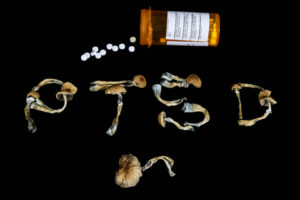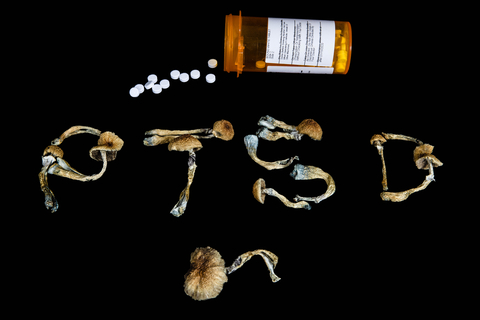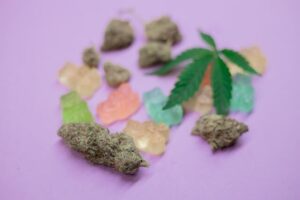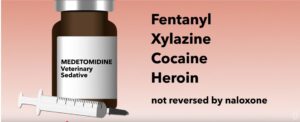
Psychedelics like psilocybin are getting a significant amount of research attention in the ongoing search for new treatments of psychiatric disorders like depression, anxiety and OCD. A new study in Nature Mental Health by Petridis et al suggested that psilocybin-assisted psychotherapy may be helpful for individuals experiencing cancer-related distress. Petridis told PsyPost he was surprised by the consistent improvements across multiple psychiatric dimensions. “The lasting impact of a single psilocybin session combined with psychotherapy was particularly remarkable.”
The researchers noted how psilocybin-assisted psychotherapy (PAP) has shown promise when treating mood disorders and anxiety in cancer patients, but PAP’s effects on psychiatric symptoms beyond these remains largely unknown. They pooled unpublished data from two phase II, randomized placebo-controlled crossover trials involving 79 participants with cancer-related distress. And then analyzed the effects of PAP on 9 psychiatric symptom dimensions (anxiety, depression, hostility, interpersonal sensitivity, somatization, obsession-compulsion, paranoia, phobia and psychosis) with the Brief Symptom Inventory. Their findings suggested PAP had potential as a comprehensive mental health treatment for cancer patients. Petridis told PsyPost:
Patients with cancer endure profound psychological challenges alongside their physical illness, yet many find little relief from existing antidepressant medications. By studying psilocybin-assisted therapy for this population, my goal is to offer hope and contribute to the development of novel treatment strategies for those who have lacked effective mental health care.
The participants ranged in age from their 30s to their 70s and had an average age of 55. Most had advanced or recurrent cancers. They were randomly assigned to receive either a high dose of psilocybin or a control treatment, followed weeks later by the alternate therapy. The control treatments included niacin and a very low dose of psilocybin designed to mimic a placebo. “Each participant underwent two psilocybin or placebo sessions, with psychotherapy provided before, during, and after each session.”
The effects were consistent across the two clinical trial sites, which added reliability to the findings. Participants showed improvements after receiving the high dose of psilocybin. Those who received it in their first session showed early improvement, while those who began with the control treatment reported benefits after they received their second phase of high dose psilocybin. Limitations of the study included many of the participants had previous experience with psychedelics; they were mostly white, well-educated and financially secure. Also, the therapists in the trial often guessed correctly whether participants received psilocybin on not, breaking the blind and introducing potential bias.
Petrides hoped to replicate these findings in larger, more diverse populations and ultimately integrate these therapies into mainstream care to enhance mental health outcomes. He thought psilocybin-assisted psychotherapy represented a promising mental health treatment. He said, “It’s essential to approach this therapy with rigorous clinical protocols to ensure safety and efficacy.”
Another study by Erritzoe et al for The Lancet eClinicalMedicine compared psilocybin to escitalopram (Lexapro) and found while both drugs improved depressive symptoms over a six-month follow up, psilocybin offered additional benefits. Patients taking psilocybin reported improvement on psychosocial functioning, meaning in life, and psychological connectedness. They also reported fewer adverse events.
The study included 59 adults with Major Depressive Disorder with a mean age of 41. The psilocybin group received two 25-mg doses of psilocybin therapy, and the escitalopram group received 10-20 mg of daily escitalopram plus two 1-mg doses of psilocybin. Both groups received psychological support. The researchers thought their findings warranted further research. Previous studies thought psilocybin might have a long-term effect, but this was the first study that followed-up for a longer, 6-month time period. Medscape also quoted Dr. Erritzoe as saying:
The study suggests that psilocybin therapy might be a more holistic treatment option for depression. . . This could make a substantial difference in the overall happiness and daily activities of those suffering from depression, providing a more joined-up approach to mental health treatment.
Another one of the researchers in the Erritzoe et al study said he thought while many therapists were unfamiliar with psilocybin-assisted psychotherapy, “it’s not a difficult skill to master.” He acknowledged it may require some specialized training, but thought a good psychotherapist could learn to implement psilocybin into their practice. He envisioned psychiatrists working with psychotherapists in a therapy program. “The psychotherapists would be more in charge of the active guiding, and the psychiatrist would do the prescribing, with the follow-up psychological support on Zoom.” But psilocybin is still a Schedule I substance, making it illegal under federal law.
Decriminalizing and Legalizing Psilocybin
The movement to decriminalize psilocybin began in 2019 when Denver Colorado became the first city to decriminalize it in May. Other cities, including Seattle, Detroit, Washington D.C., and Oakland California have followed suit. In 2020, Oregon voters passed a ballot measure to both decriminalize psilocybin and legalize its supervised use. Colorado followed with a similar measure in 2022. Missouri legalized psilocybin treatment for veterans over the age of 21 who suffer from PTSD, major depressive disorder, and substance use disorders.
According to the Oregon Health Authority, there are 350 licensed facilitators and a dozen manufacturers in the state. People who want to use psilocybin must consume it at a licensed service center under the supervision of a licensed facilitator. The facilitator remains with them for the duration of the trip. By and large, they say it is extremely safe. “This is essentially a mental health clinic where someone is here all day with us.” Reportedly, over 16,00 doses have been administered since June 2023, with staff at such centers only calling 911 or taking an individual to the hospital five times.
While Oregon seemed to be a progressive leader in being the first state to legalize the therapeutic use of psilocybin, four years later it has a growing list of cities that have banned the substance. Four cities, spanning Portland suburbs as well as rural and coastal towns, added new voter-approved prohibitions for the substance in November 2024. “A dozen other communities that approved two-year moratoriums in 2022, when a majority of Oregon counties and over 100 cities voted to temporarily or permanently ban psilocybin, voted in this election to make the restrictions permanent.”
In 2020, roughly 56% of Oregon voters approved Measure 109, which allowed for the manufacture and controlled, therapeutic use of psilocybin at licensed facilities for those over 21. But the measure allowed counties and cities to vote to opt out, resulting in a patchwork of regulations across the state.
The founder of Psychedelics Alpha, Josh Hardman, speculated that perhaps the drug policy reform pendulum was swinging back towards prohibition as part of a broader trend towards ‘law and order’ among American voters. Nevertheless, despite the local bans, psilocybin is still accessible in over 30 licensed centers spanning Oregon’s most populous cities like Portland, and a handful of small towns. However, it is out of reach for many, costing up to $2,000 out of pocket for one session. “The cost for the program has been astronomical and is not accessible to people across the socioeconomic spectrum.”
Writing for The New York Times, Michael Pollan, the author of How to Change Your Mind, said he looks forward to the day when psychedelic medicines like psilocybin have proved their safety and efficacy in FDA-approved trials. He’s worried that ballot initiatives were not the smartest way to get there.
We still have a lot to learn about the immense power and potential risk of these molecules, not to mention the consequences of unrestricted use. It would be a shame if the public is pushed to make premature decisions about psychedelics before the researchers have completed their work. There is, too, the risk of inciting the sort of political backlash that, in the late 1960s, set back research into psychedelics for decades.
Pollan said 50 years later we were still struggling to “learn how best to harness their spooky power.” He noted there was a report of archaeologists finding a 1,000-year-old set of tools in Bolivia bearing trace amounts of ayahuasca and other psychoactive chemicals. For the most part in ancient cultures, “psychedelic substances were always approached with deliberateness and care.” The substances were only used on certain occasions and were surrounded by ritual and with a clear purpose. “There was nothing casual about it.”
In the clinical trials where psychedelics are being tested as psychiatric treatments, these substances are paired with psychotherapy, but the therapeutic element is minimally described in most studies. A systematic review of 45 studies of psychedelics published in The Lancet said there was no consensus of what is considered best practice for the psychotherapeutic component of psychedelic treatments. “Improved reporting on psychological interventions of psychedelic treatments will support replicability, generalisability, and accurate interpretation of research, while enhancing feasibility and safety of future clinical research and real-world implementation of treatments.”
Livescience noted how this was a big problem and had played a part in the FDA’s decision to reject MDMA-assisted therapy for PTSD in the summer of 2024. An interview with one of The Lancet study’s researchers said the descriptions were very different between studies, making it hard to extract information in a systematic way. He also noted where there had been an incident where a patient was sexually abused by her therapy providers in a MAPS-sponsored clinical trial for MDMA-assisted therapy. This led to published papers being retracted because the ethical violation wasn’t disclosed to the journal before publication. He thought facilitators should at least have the professional experience required for someone applying psychotherapy outside of psychedelic-assisted therapies.
One of the fundamental elements in therapy is this concept of “continuing consent” — so I can be in a therapeutic session with the patient, and the fact that the patient, at any moment, can make a decision to interrupt that session and leave is an incredible element of safety. When the patient is under the influence of a mind-altering substance, that’s changed.
See “The Long Strange Trip of MDMA-Assisted Therapy” for more information on the FDA’s rejection of MDMA-assisted therapy.
Ancient Psychedelics and Shamanistic Healing Rituals
In 2008 an anthropologist from Pennsylvania State University in State College and colleagues discovered a 1,000-year-old bag containing a variety of psychoactive compounds. Later analysis identified five psychoactive substances: cocaine, benzoyleconine, bufotenine, harmine, and dimethyltryptamine. Harmine and dimethyltryptamine are the main ingredients in ayahuasa, which has been used ceremonially for centuries by indigenous South Americans. Some researchers think ayahuasca has potential to treat mood disorders, PTSD, substance use disorder and eating disorders.
The ritual bundle consisted of a large leather bag, two carved and decorated wooden snuffing tablets, an anthropomorphic snuffing tube, two bone spatulas, what is thought to be a headband, and an animal-skin pouch made from three fox snouts. The presence of the snuffing tube and tablets suggest the substances were inhaled long before they were brewed into a beverage, as is now the custom with ayahuasca. See: “Shamanistic Healing with Ayahuasca.”
An international group of archaeologists published a research article on their analysis of the ritual bundle in the Proceedings of the National Academy of Sciences. They said this was the largest number of psychoactive compounds found to be associated with a single archaeological artifact from South America. It suggested that the ritual specialist or shaman might have intentionally used multiple psychoactive substances for their effects. “Maybe they were mixing multiple things together because they realized when they’re combined, they have a whole different set of experiences.”
I share Michael Pollan’s concern with ballot initiatives decriminalizing and legalizing the therapeutic use of psychedelics like psilocybin, ayahuasca, and MDMA (ecstasy), but for a different reason. I am concerned that the biased discussion of dramatic “healings” with psilocybin and other psychedelics is blurring the line between psychotherapy, medicine, and shamanistic healing rituals couched in scientific rhetoric. I agree that further study and research is needed into “the immense power and potential risk” of these substances. We need further, careful research before we approve them as “treatments” for those who already struggle with mood disorders, PTSD, and substance use.





